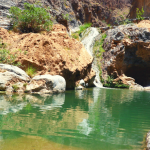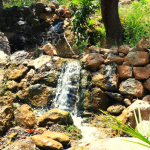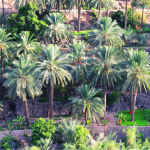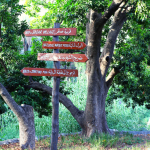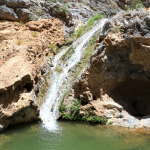Oman
Wadi Bani Kharus: Where Nature And Civilization Meet In Harmony

The Sultanate is chock-full of tourist potentials that constitute an important asset to the national economy. One of these important tourist destinations is Wadi Bani Kharus in the Wilayat of Al Awabi, the Governorate of South Al Batinah.
Wadi Bani Kharus can be considered one of the more famous valleys in the region that bears witness to ancient Omani history, alongside a plethora of flora, and a dose of agricultural crops to pepper the otherwise brown lands with greenery.
Couple that with fauna to match, aflaj, mysterious rock formations, and archaeological inscriptions on stones and old houses, and the wadi quickly becomes an indispensable cultural hotspot in the Sultanate.
Also playing the role of a life giver in the region, the wadi has been key to irrigation in villages and orchards along the valley for centuries.

Located some 140-kms from the Governorate of Muscat, and linked by paved roads for most parts of your journey, the wadi can still be an escape for those looking for a quick weekend R&R.
Visitors to the region can begin their journey at the Al Awabi fort in a trip that will take them back in time as they traverse historic villages, agricultural lands, and the famous Safun valley.

Once there, you can partake in trekking, hiking or a night of camping under the starry skies that span above the vast horizon. For most parts of the year, the wadi stays alive with crystal-clear water; all flowing from the mountains of Al Jabal Al Akhdar.
It’s a tranquil setting in comparison with the bustling cityscape of Muscat.
Those looking to chase down adventure can try their hand at trekking up to the village of Al-Sujara in Al Jabal Al Akhdar, which is a four-hour-long trek through the rocky mountains of the A’Dakhiliyah region. The Ma’awal Cave is also must-visit for the daring.
If soul-searching is what you’re after, you could take a trip to the Areesh Al-Hail mosque; though, it must be noted that mosques remain closed as a response to the Supreme Committee’s efforts to curb the Coronavirus.
However, you can safely interact with locals in the area who can share insights on how the region gained importance for its assistance in the formation of the deep-rooted Omani culture that we see and experience today.

History books have recorded news of imams, scholars, poets, writers and various events of this Wilayat and its famous valley through the formative years of the region, so, those visiting the wadi are advised to respect the sentiments of its residents.
But the multi-faceted locale still serves up a dollop of adventure to the daring while keeping its culture close to its heart, enough to have our thoughts wandering in awe through the best that nature and civilization have to offer.
*This article was originally published by ONA but has since been edited for clarity.
-

 Dossier2 months ago
Dossier2 months agoDossier Construction Awards 2025 Celebrates Pioneers in Construction, Infrastructure and Real Estate
-

 Arts and Culture2 months ago
Arts and Culture2 months agoROHM To Premiere Arabic-Language Grand Opera – ‘Sindbad: The Omani Sailor,’ on Oct 3 and 5
-

 News2 weeks ago
News2 weeks agoKitchenomiKs Secures Investment of US$3.2M Led by Jasoor Ventures
-

 Insurance1 month ago
Insurance1 month agoLiva Insurance Sweeps Three Major Wins at Alam Al-Iktisaad Awards 2025
-

 Magazines3 weeks ago
Magazines3 weeks agoOER – September 2025 Issue
-

 News4 weeks ago
News4 weeks agoCent Capital, AI Finance App by ex-AWS Strategist ‘The Beast of Bay Area,’ Launches to End Financial Anxiety, Hits $1M AUM
-

 News3 weeks ago
News3 weeks agoIEA Expects Global Oil Market to Remain Oversupplied in 2026
-

 News3 weeks ago
News3 weeks agoOman Inaugurates ‘Hadatha’ – Its All-New Cybersecurity Center



